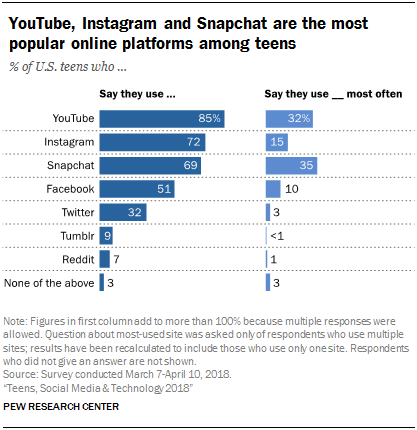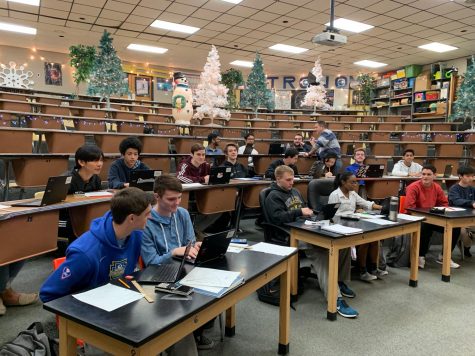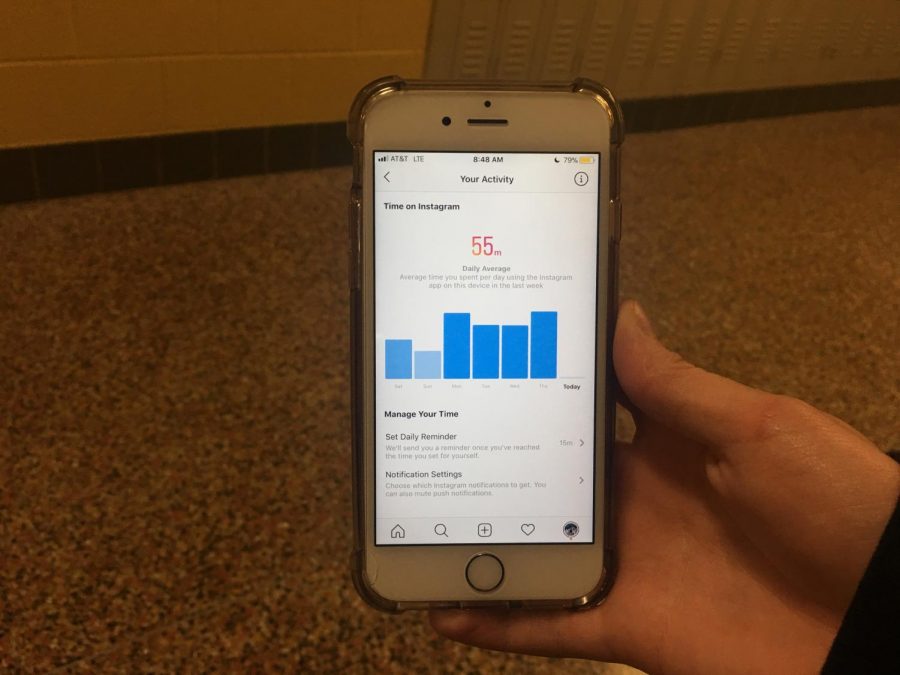Snapping our lives away
An up close look at social media usage among the high school population
It’s the most important playoff game so far for the North Penn football team. The team is down by three with only four nail-biting seconds left as North Penn has the ball. As the clock ticks down, North Penn rushes into the end zone scoring the game-winning touchdown. The usual cheers don’t fill the stadium as everyone in the student section was too busy scrolling through Instagram or snapping selfies to realize that North Penn had won.
The rapidly growing popularity of social media is like one of those monsters that hatch from the eggs overnight if you left it in water. It has been become more prevalent in youth culture in the last 10 years and consumes our everyday life as we spend our time looking at one screen to the next obtaining all the new information presented. Popular social media outlets like Youtube, Instagram, and Snapchat, allow teens to make friends, stay connected, and promote their own form of self-expression and identity. Roughly, teens spend about 9 hours in front of a screen, inevitably snapping their life away.

“I am obsessed with Instagram, so I am always on it… I am on my phone about 5 hours a day. Throughout the day, [I’m] always on it all the time,” stated North Penn student Ibnat Hamidi.
As social media changes through time, youth culture advances with it. Regardless if a student has social media apps or not ,when they come to a school like North Penn, they are inevitably going to be placed in front of a screen by first period. Technology is a huge innovation that schools like North Penn are trying to incorporate into the curriculum more and more every year. For example, when the class of 2020 was in 1st grade, all the classes in a grade would meet to watch a video on the big chunky TVs. Teachers would have to find an extension cord long enough to plug it in because only some of the lucky classrooms had smartboards. Flash forward about 10 years later: everyone has a portable Chromebook to take home every night, the halls of North Penn are filled with screens displaying information, and every classroom has one of the smartboards we so infamously wanted in elementary school. Without a doubt, technology and social media have impacted the way teachers teach and the way that students learn.
‘‘Some students have a really difficult time, including adults, putting that social media down,’’ recalled North Penn guidance counselor, Dr. Nicole Yetter.
Students now have been more and more reliant on social media in their daily life. Whether it’s school work, sports, or their home life, social platforms have become a big part of our society today. As technology grows, it makes it more and more difficult for kids to put down social media, since youth culture is so reliant on it.
Without question, social media plays a huge factor in our education today and influences how we are taught and our in-school experience overall. Almost every high school student has used Sparknotes or Shmoop to get passed the dreaded 50 page assignments of reading Moby-Dick or A Tale of Two Cities, and if they tell you they haven’t, they are most likely lying. Social media and the internet become an online cheat sheet for students and actually poses as an educational advantage for some.

Josie Lemon, a NPHS junior spends a little quality time on social media.
“[Social Media] actually helps… I was never really a smart person… and access to the internet and media let me have a better understanding of the world,” recalled Hamidi.
However, through constant scrolling and snapping, it is easy for students to get caught up in the digital world instead of paying attention to what’s really going on around them in school. Even though social media makes it easy for students to work smarter and not harder, as Mr. Dwight Homan would say, can it also come with downfalls?
“If I wasn’t on my phone in school, I would have way better grades than I do right now,” recalled Sarah Furek.
With every decision we make or topic we are discussing, there’s always a huge list of pros and cons that we have to weigh, and social media comes with a lot of them. Some pros of being indulged in the digital world is that it increases communication. If a teacher needs to reach a parent or student, it takes no more than 10 minutes to send out a quick email. Social media also provides a sense of community and unity for some in a case of a crisis. Anonymous apps like Whisper allows people to say anything they want ranging from accomplishments, random thoughts, or what they have been struggling with on the other side of the screen. Other users can provide them with support, advice, and comfort they may not get in the real world. Social media apps like Instagram and Facebook keep families and friends connected who may not see each other all the time.
“I have family all over the country, how we stay in touch is social media. What other way can I see pictures of my cousins kids and family?” responded Kristen Panaski, a health and physical education teacher at North Penn.
When you go up, there’s only one way down. And for social media, it comes with a lot of cons we have to consider like the issue of cyberbullying and mental health. With apps like Instagram, it is so easy for someone to leave a rude comment, and to ruin somebody’s day. It is also inevitable that it will warp what we want to define as beauty, as almost 90% of girls on social media admitted to hating their bodies. Isn’t it ironic that Instagram is one of the most used apps of our generation, but it is the app that causes more cases of depression and anxiety, unlike any other platform?

NPHS Students at the end of a class period – It does not take long for students to get right back on their phones when a class ends. The connection between social media and students is tough to break.
Platforms like Instagram, Snapchat, and even Facebook construct this idea of what teens lives should be like, and with that can come insecurities. Numerous amounts of teens are pressured by social media to conform to be like others. Teens who spend 5 or more hours a day on social media have a 71 percent more likely chance to have a suicidal risk factor than those who spend less than one hour. Constant Social media use clearly impacts students’ mental and social health as well as their education.
“The Victoria Secret Fashion Show was just on tv…. And you just see people [on instagram] and you want to be like them… and in reality, you will never be like them. Social media just creates an image of stereotypes which makes you insecure,” informed Hamidi.
Social media, and the internet in general, influences our day-to-day life and mainly consumes the attention of teenagers. The effect it has on our education and more importantly, our mental health, plays a big factor in how we learn and how we think of ourselves.
Yetter also reflected, “ You never want to miss out on the next greatest thing,’’
Youth culture is always getting caught up in the new trends on social media, and always wants to obtain the next big thing. Social media and the internet creates a fast communication system between friends and family and establishes a sense of identity for some with the use of Instagram and Youtube.
Inevitably, social outlets have a major importance in our everyday life. Whether you see social media as a positive or a negative, it ends up like an earthquake; you never saw it coming, but once it hits, the impact will leave an everlasting mark.
SOURCES USED IN THIS ARTICLE
www.pewinternet.org
www.variety.com
www.assets.pewresearch.org
www.childmind.org
www.neatoday.org



Ryan Voron • Dec 19, 2018 at 9:56 am
I like the transition from the football game to Social Media. Paper to Chromebook connection for learning purposes was well done. The article tells the reader the downside to having our phones in school.
Rebecca Brandolph • Dec 19, 2018 at 9:36 am
This article is great, and a little scary because it’s so true.
David Baik • Dec 19, 2018 at 9:35 am
This article is very insightful. I agree with your points that many teens are becoming reliant on their phones and social media, whether it be for personal gratification or a Shmoop analysis. And social media is a tough problem because in spite of all its problems, there are many benefits to social media, like how Mrs. Panaski is able to keep in touch with her family through it. Overall, this article was an interesting read; the intro and conclusion were both very impactful.
Casey Nielsen • Dec 19, 2018 at 9:30 am
I like how the article has insight from a student and teacher perspective. It also lists a lot of pros about technology and social media, not just the cons.